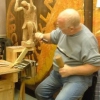This lesson is about finding your way around a typical carving gouge - and I'll take the handle off to show you.
Knowing and naming the various parts of your carving tools enables you to talk meaningfully about them to other carvers.

| 09 June 2015 12:03
Muhammad - Yes, these generic terms are the same for all carving tools - except there will be the equivalent words in other languages: German (Pfeil) or French (Auriou) for example.

| 09 June 2015 05:51
Chris, the tools parts you mention are they the same for Pfeil tools?

| 04 November 2013 08:16
Jeanne - The tempering isn't usually visible but you can assume a tool from a reputable maker is tempered the whole length of the blade, stopping short of where this turns into the shank. That's a grey area, so to speak, and will vary with the manufacturer. It is indeed wonderful having old gouges (Have you seen what I say about them in the BBC Green Man clip? Relief Carving > Green Man, first off.), but at the end of the day, when it comes to a stunning piece of work, it's the carver behind the gouge that counts!

| 01 November 2013 15:49
Chris can we visually tell if a tool has been tempered to a particular length? Some old tools don't have labels either by wear or by change of handle? Congratulations to you and Clive on having some very special tools. I hope I become that fortunate.

| 22 August 2013 13:32
This is something that "I" have never seen explained before. Great! I am lucky enough to be the owner and user i.e. the "Keeper" of 18 carving chisels and gouges that belong to the author Charles Hayward, they are all Addis from around 1800's, They are a pleasure to carve with.

| 18 April 2013 15:58
Ronald - I would expect all well-establish carving tool manufacturers to temper the whole of the blade down to say an inch from the shoulder - the opposite, in fact, of what you've heard. This is one of the reasons I can still use a carving tool that is 120 years old and half it's original length, and why you'd really need more than one lifetime to wear out a gouge!

| 18 April 2013 15:06
Chris
You may have mentioned this, but how far back from the blade edge is the steel tempered? Does it depend on which brand? I recently heard only an inch or two before you run into soft metal.

| 30 May 2011 01:34
informative